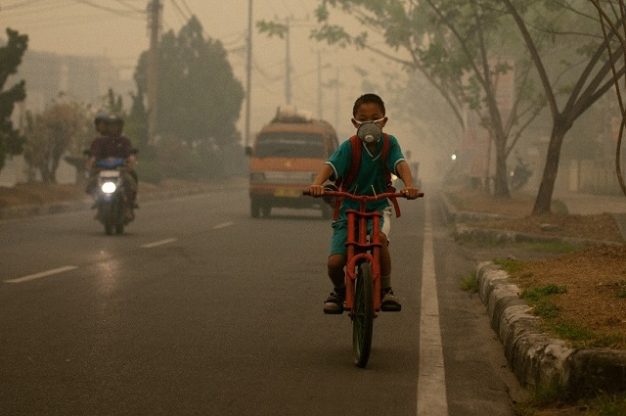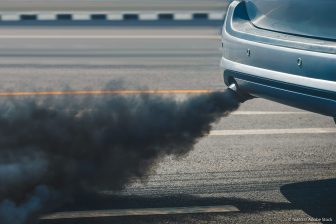
‘The world’s richest countries are destroying children’s environments globally’ – UNICEF
They might be providing healthier environments for children within their own borders, but some of the world’s richest countries like The Netherlands, Finland and Iceland are ‘disproportionately contributing to the destruction of the global environment’.
Children’s charity UNICEF goes further, saying that the majority of wealthy countries are creating ‘unhealthy, dangerous and noxious conditions’ for children across the globe.
Those are some of the key conclusions of the charity’s latest Report Card, Innocenti Report Card 17: Places and Spaces, which compares and contrasts how 40 countries in the Organisation for Economic Co-operation and Development (OECD) and European Union (EU) fare in providing healthy environments for children
It focuses on key indicators including exposure to harmful pollutants such as poisonous air, pesticides, damp and lead; access to light, green spaces and safe roads; as well as countries’ contributions to the climate crisis, consumption of resources, and the dumping of e-waste.
If everyone in the world consumed resources at the rate people do in OECD and EU countries, says the report, the equivalent of 3.3 earths would be needed to keep up with consumption levels.
And if everyone were to consume resources at the rate at which people in Canada, Luxembourg and the United States do, at least five earths would be needed.
While Spain, Ireland and Portugal feature at the top of the league table overall, all OECD and EU countries are failing to provide healthy environments for all children across all indicators. Some of the wealthiest countries, including Australia, Belgium, Canada and the United States, have a severe and widespread impact on global environments – based on CO2 emissions, e-waste and overall consumptions of resources per capita – and also rank low overall on creating a healthy environment for children within their borders. In contrast, the least wealthy OECD and EU countries in Latin America and Europe have a much lower impact on the wider world.
‘They are contributing to the destruction of children’s environments’
Gunilla Olsson, Director of UNICEF Office of Research – Innocenti, said: “Not only are the majority of rich countries failing to provide healthy environments for children within their borders, they are also contributing to the destruction of children’s environments in other parts of the world.
“In some cases we are seeing countries providing relatively healthy environments for children at home while being among the top contributors to pollutants that are destroying children’s environments abroad.”
Findings include:
- Over 20 million children in this group of countries have elevated levels of lead in their blood. Lead is one of the most dangerous environmental toxic substances.
- Finland, Iceland and Norway rank in the top third for providing a healthy environment for their children yet rank in the bottom third for the world at large, with high rates of emissions, e-waste and consumption.
- In Iceland, Latvia, Portugal and the United Kingdom 1 in 5 children is exposed to damp and mould at home; while in Cyprus, Hungary and Turkey more than 1 in 4 children is exposed.
- Many children are breathing toxic air both outside and inside their homes. Mexico has among the highest number of years of healthy life lost due to air pollution at 3.7 years per thousand children, while Finland and Japan have the lowest at 0.2 years.
- In Belgium, Czech Republic, Israel, the Netherlands, Poland and Switzerland more than 1 in 12 children are exposed to high pesticide pollution. Pesticide pollution has been linked with cancer, including childhood leukaemia and can harm children’s nervous, cardiovascular, digestive, reproductive, endocrine, blood and immune systems.
UNICEF has outlined a series of steps which, it says, governments must take to start better protecting and improving children’s environments. One of these is calling for the following steps to protect and improve children’s environments.
One of these is improving environments for the most vulnerable youngsters. UNICEF says that children in poor families tend to face greater exposure to environmental harm than their peers in wealthier families. This ‘entrenches and amplifies’ existing disadvantages and inequities.
UNICEF also wants to:
- Ensure that environmental policies are child sensitive. Governments and policymakers should make sure that the needs of children are built into decision making. Adult decision makers at all levels, from parents to politicians, must listen to their perspectives and take them into account when designing policies that will disproportionately affect future generations.
- Involve children, the main stakeholders of the future: Children will face today’s environmental problems for the longest time; but they are also the least able to influence the course of events.
- Governments and businesses should take effective action now to honour the commitments they have made to reduce greenhouse gas emissions by 2050. Adaptation to climate change should also be at the forefront of action for both governments and the global community, and across various sectors from education to infrastructure.
“We owe it to ourselves and to future generations to create better places and spaces for children to thrive,” added Olsson. “Mounting waste, harmful pollutants and exhausted natural resources are taking a toll on our children’s physical and mental health and threatening our planet’s sustainability. We must pursue policies and practices that safeguard the natural environment upon which children and young people depend the most.”




